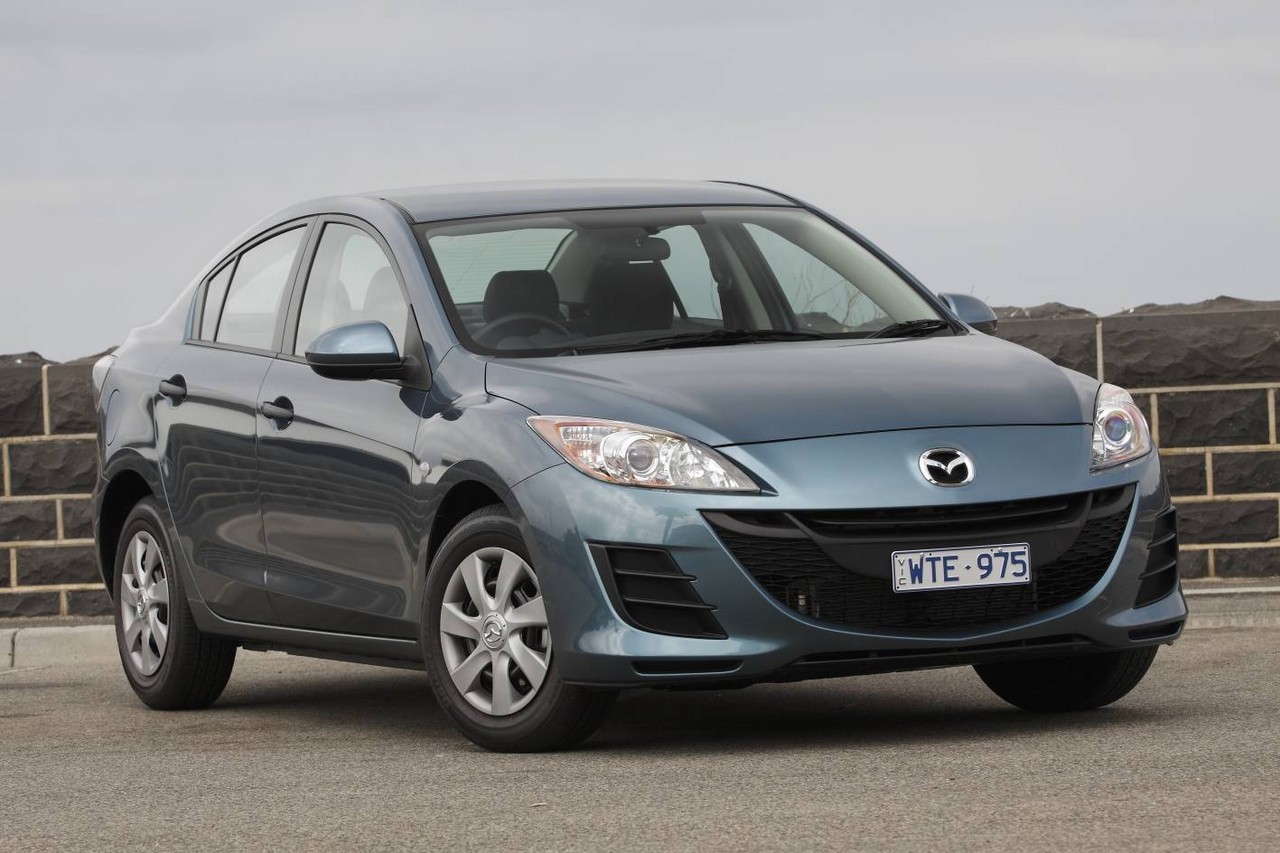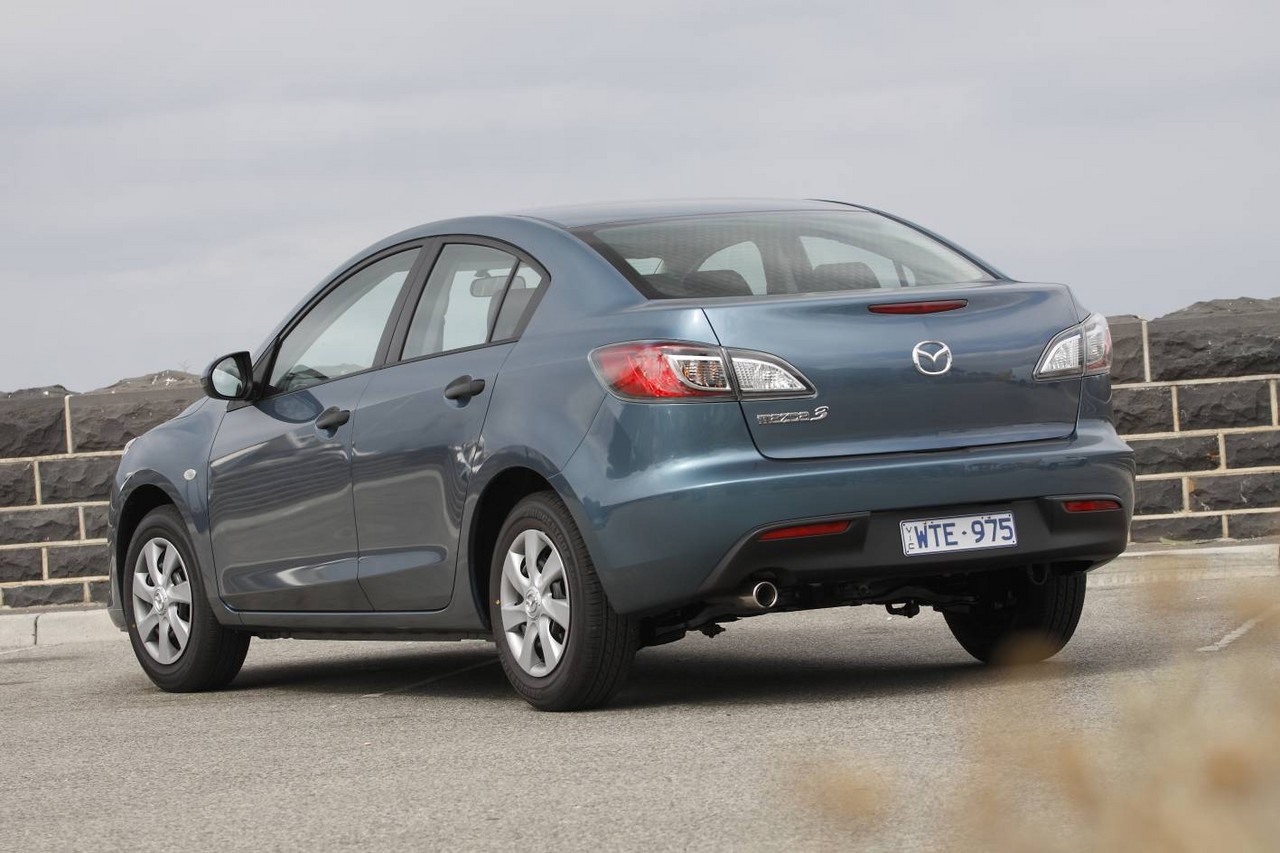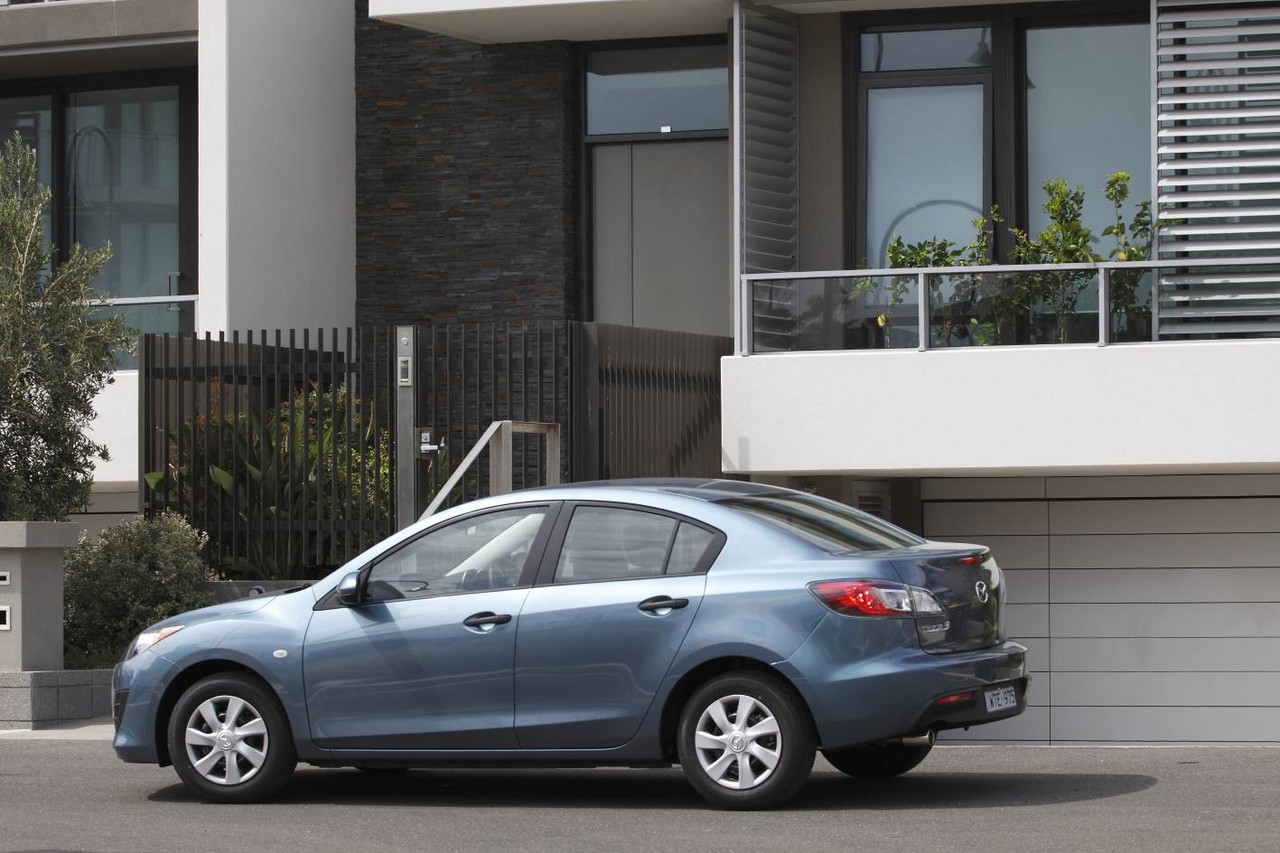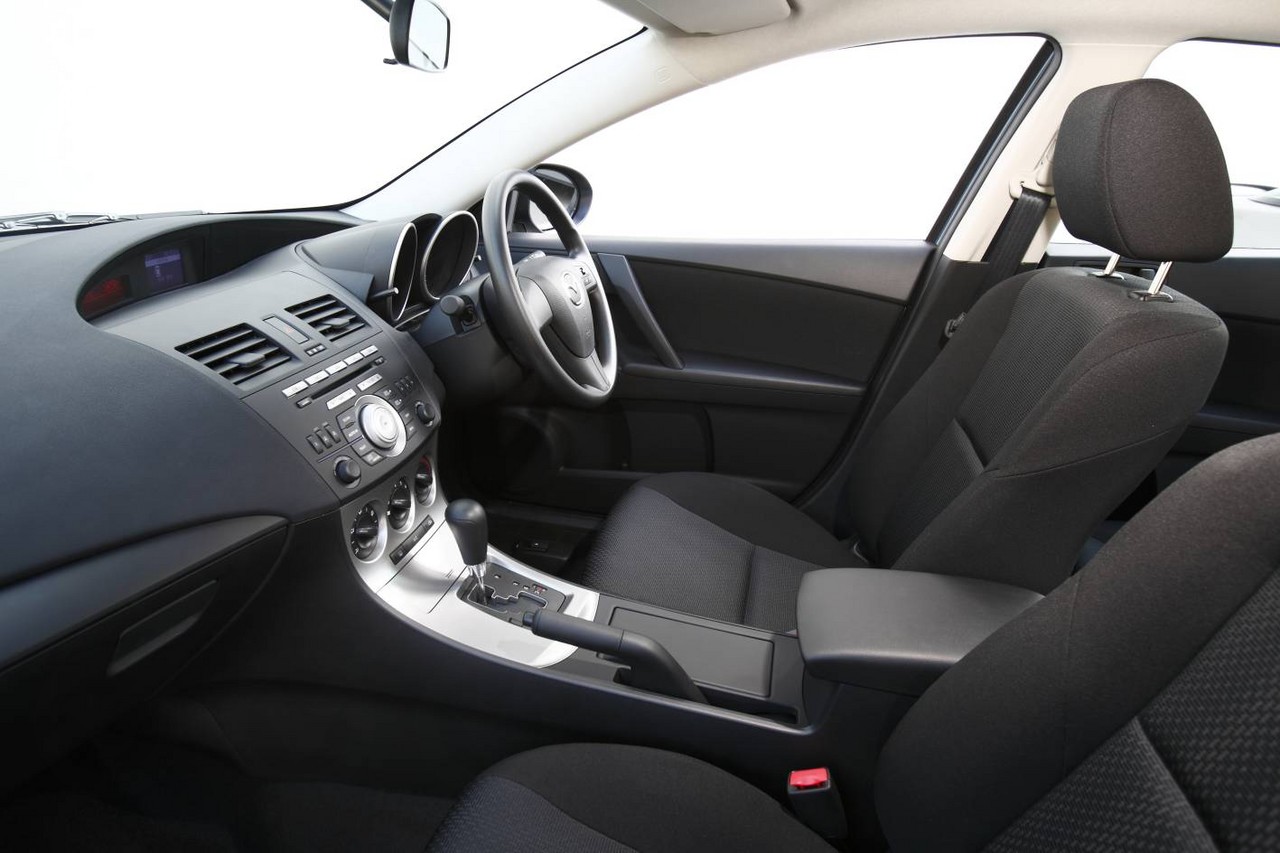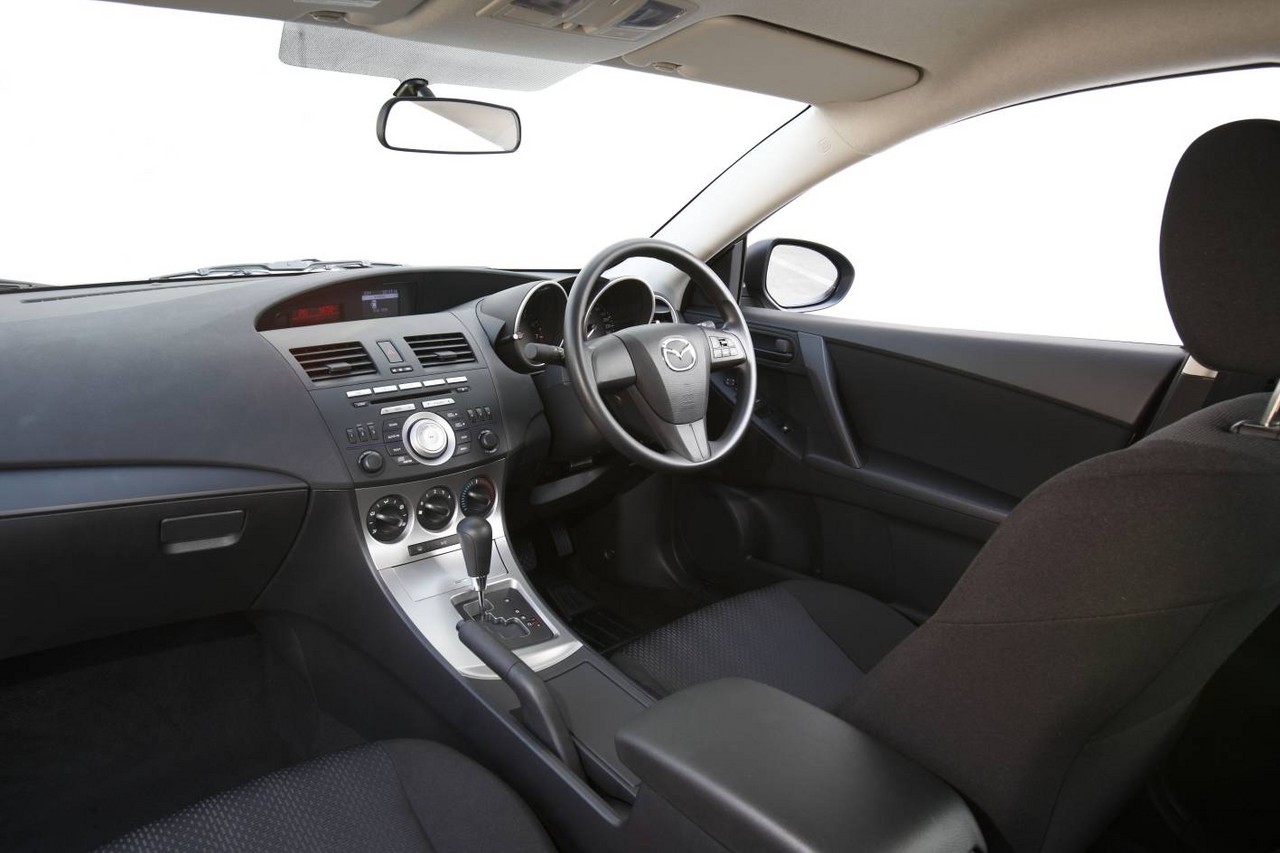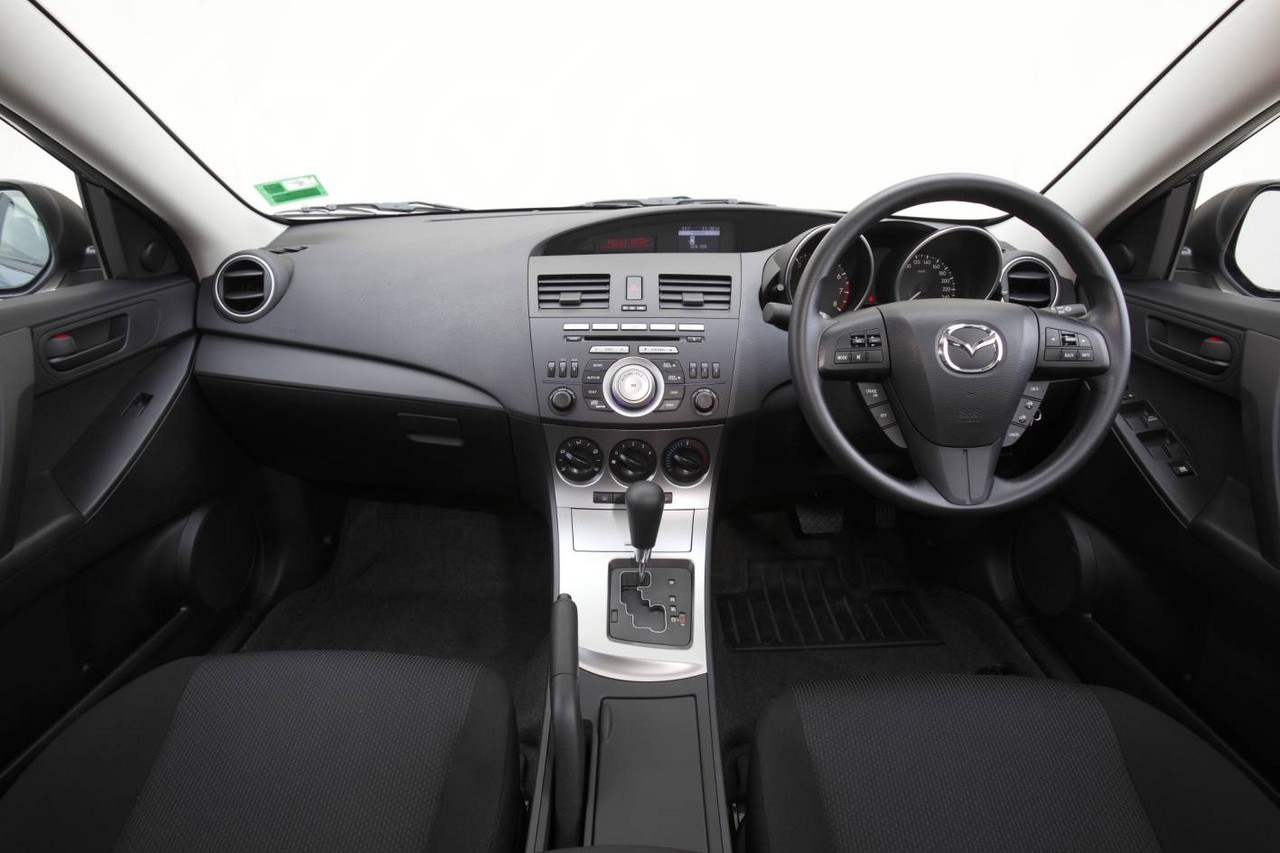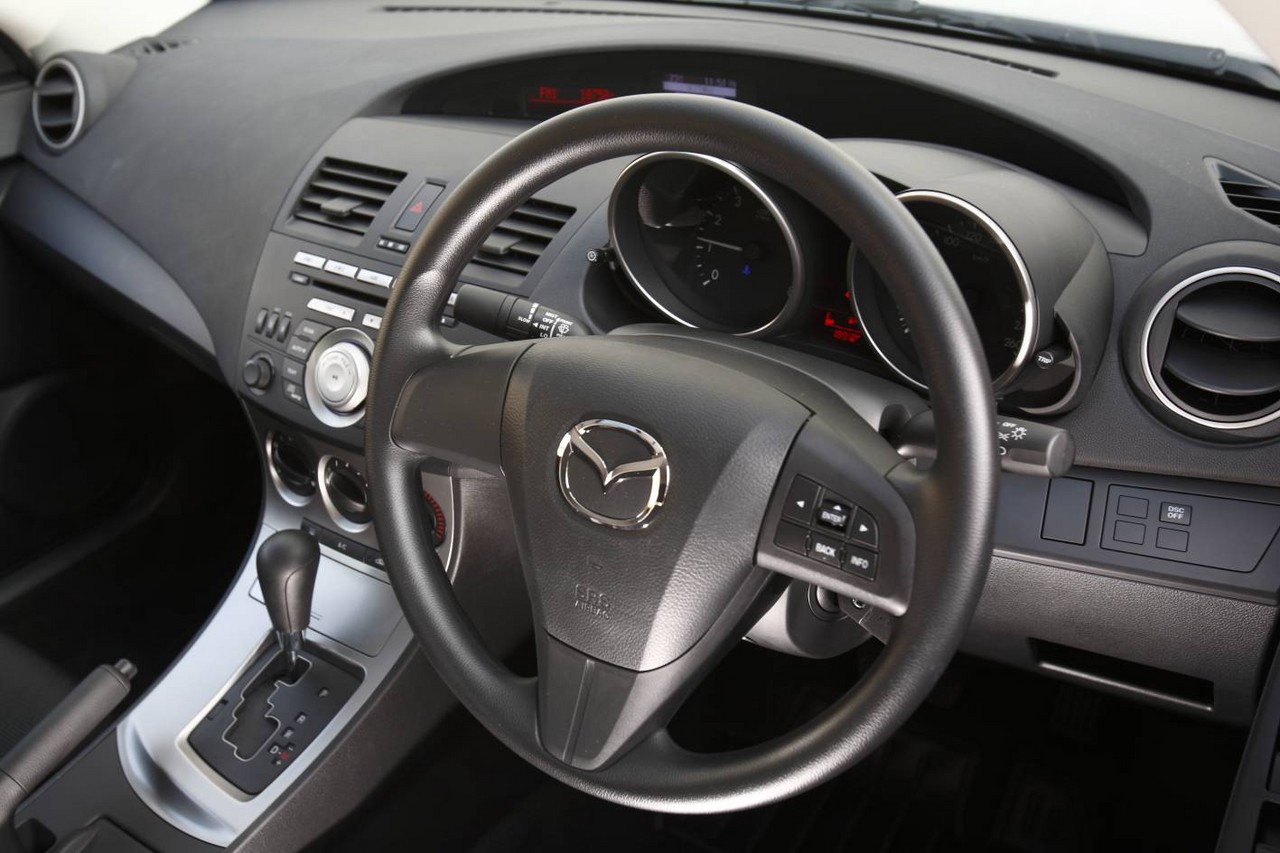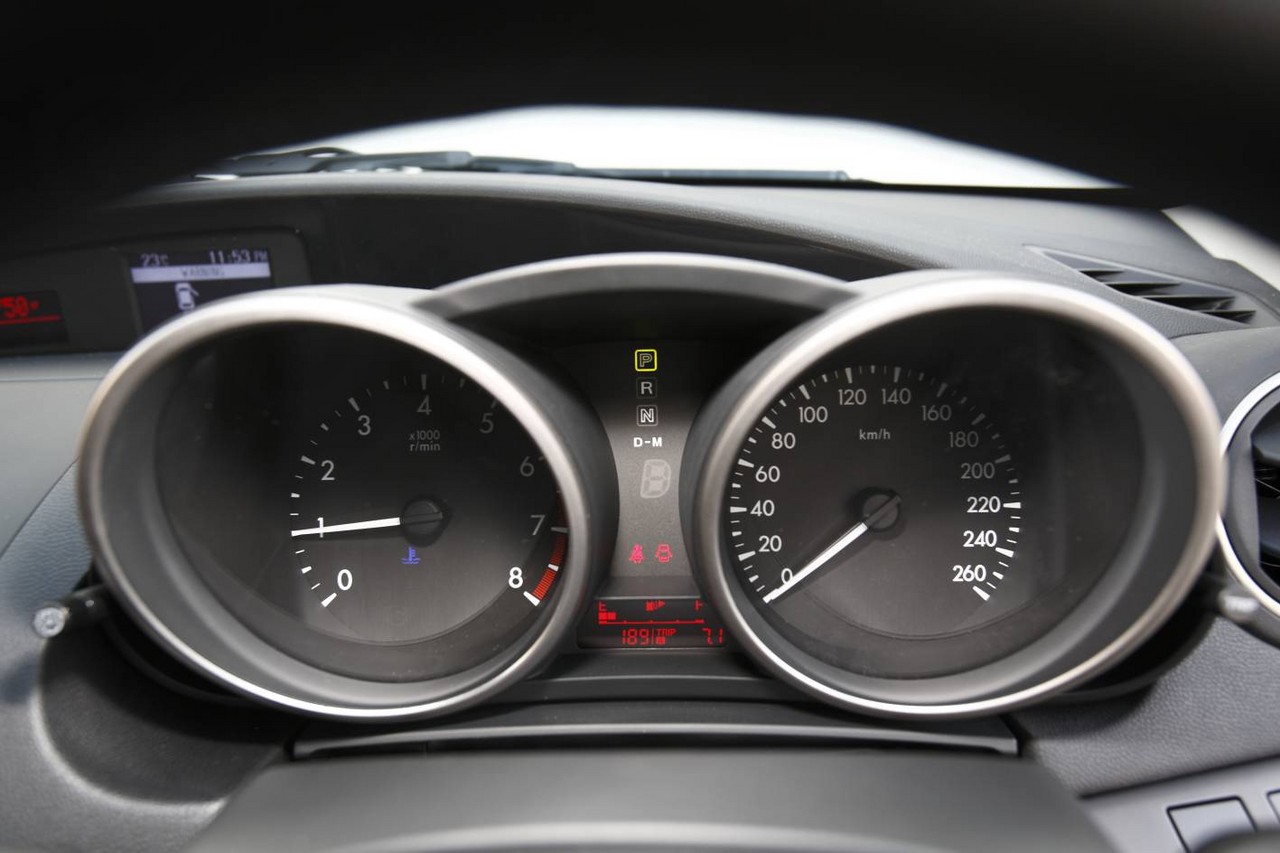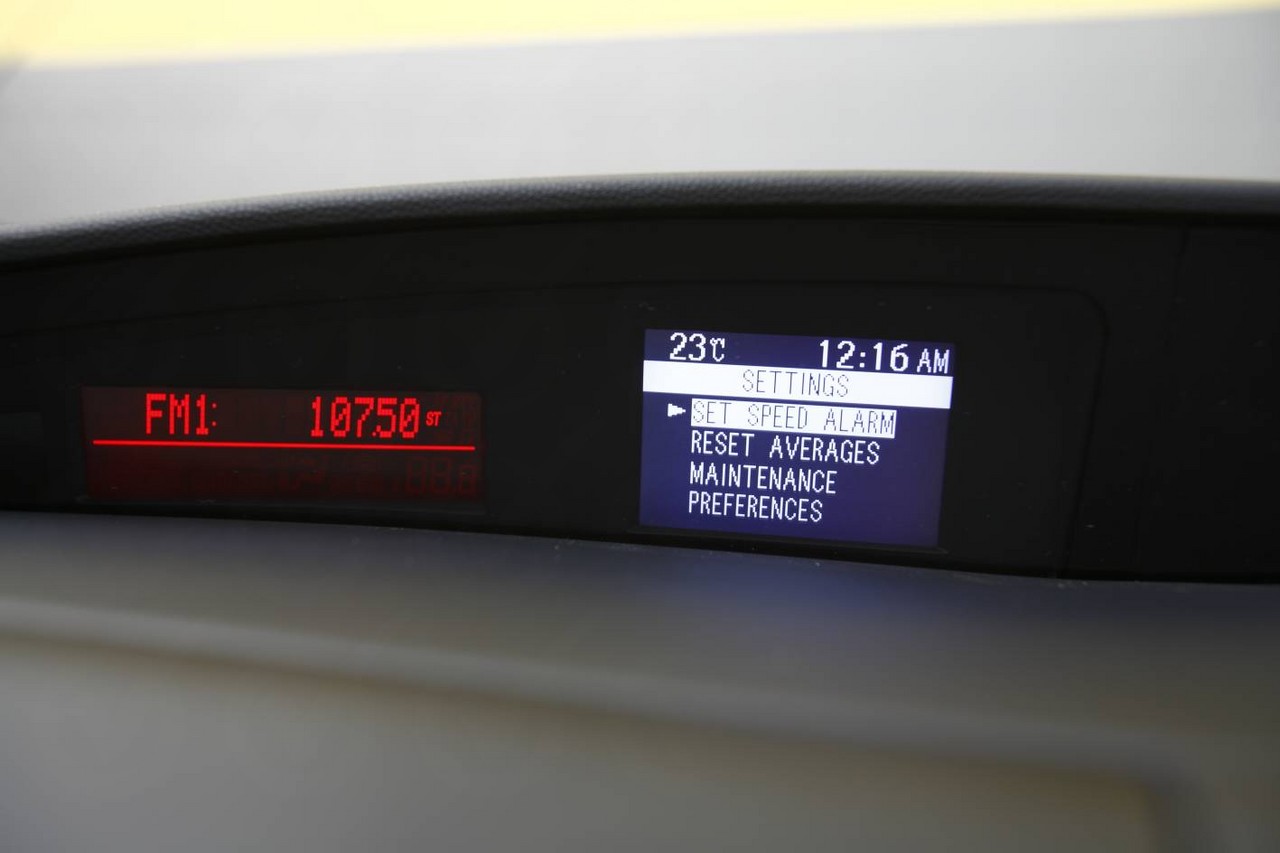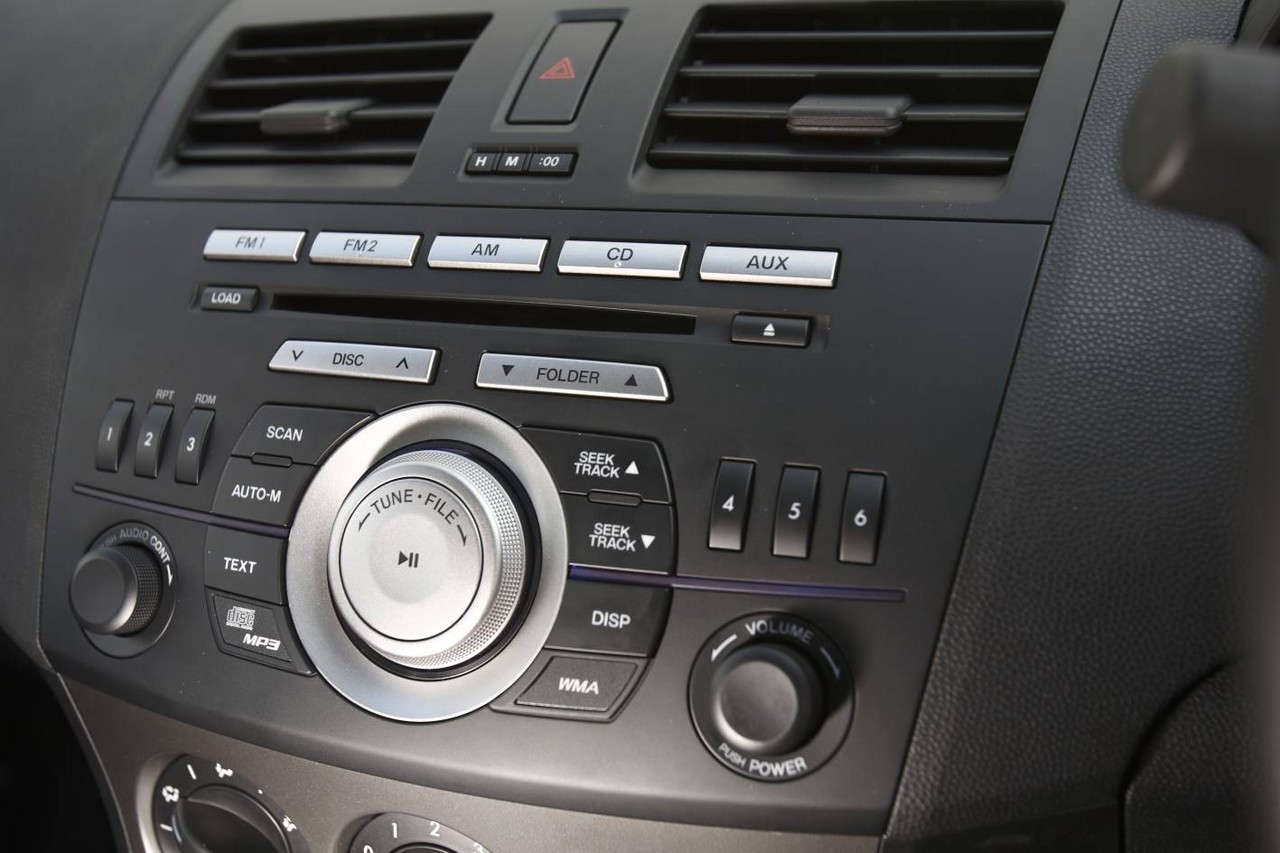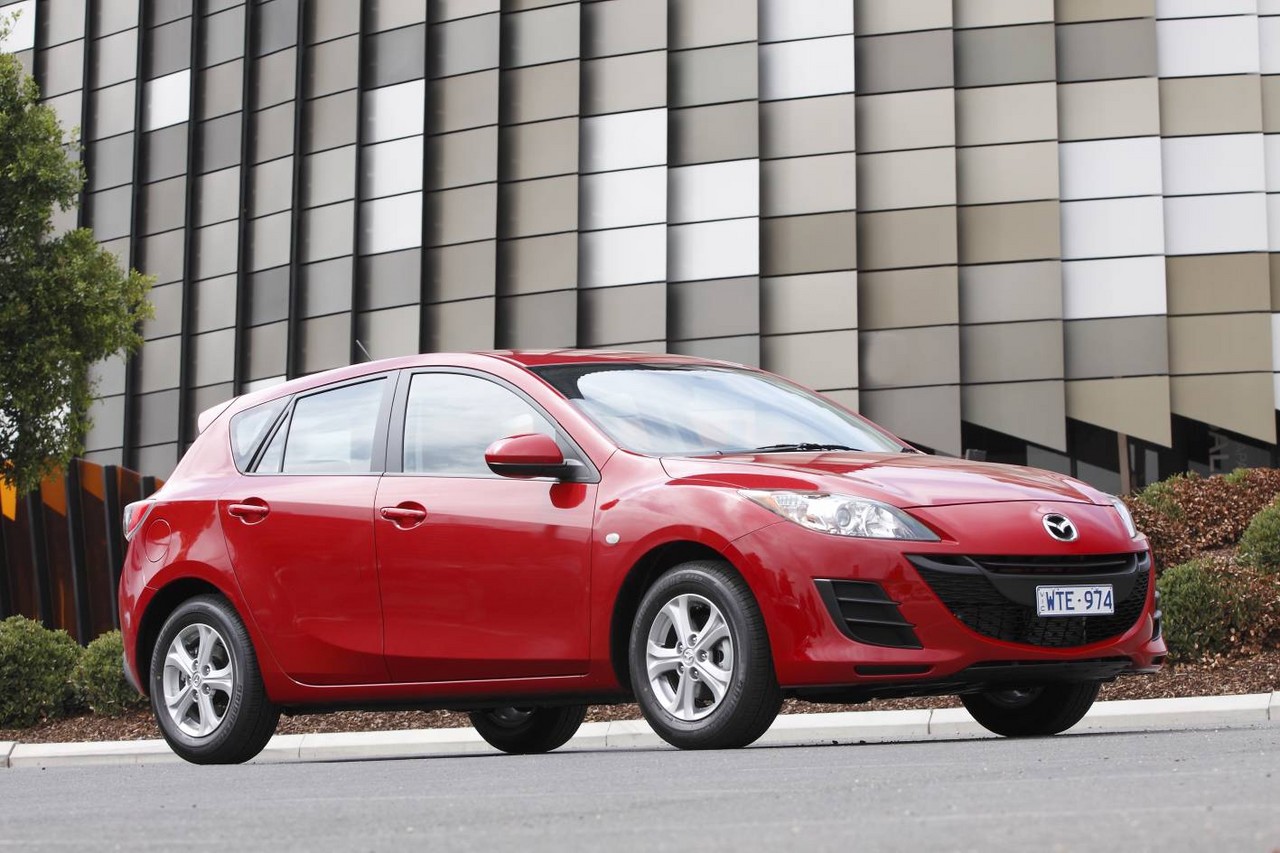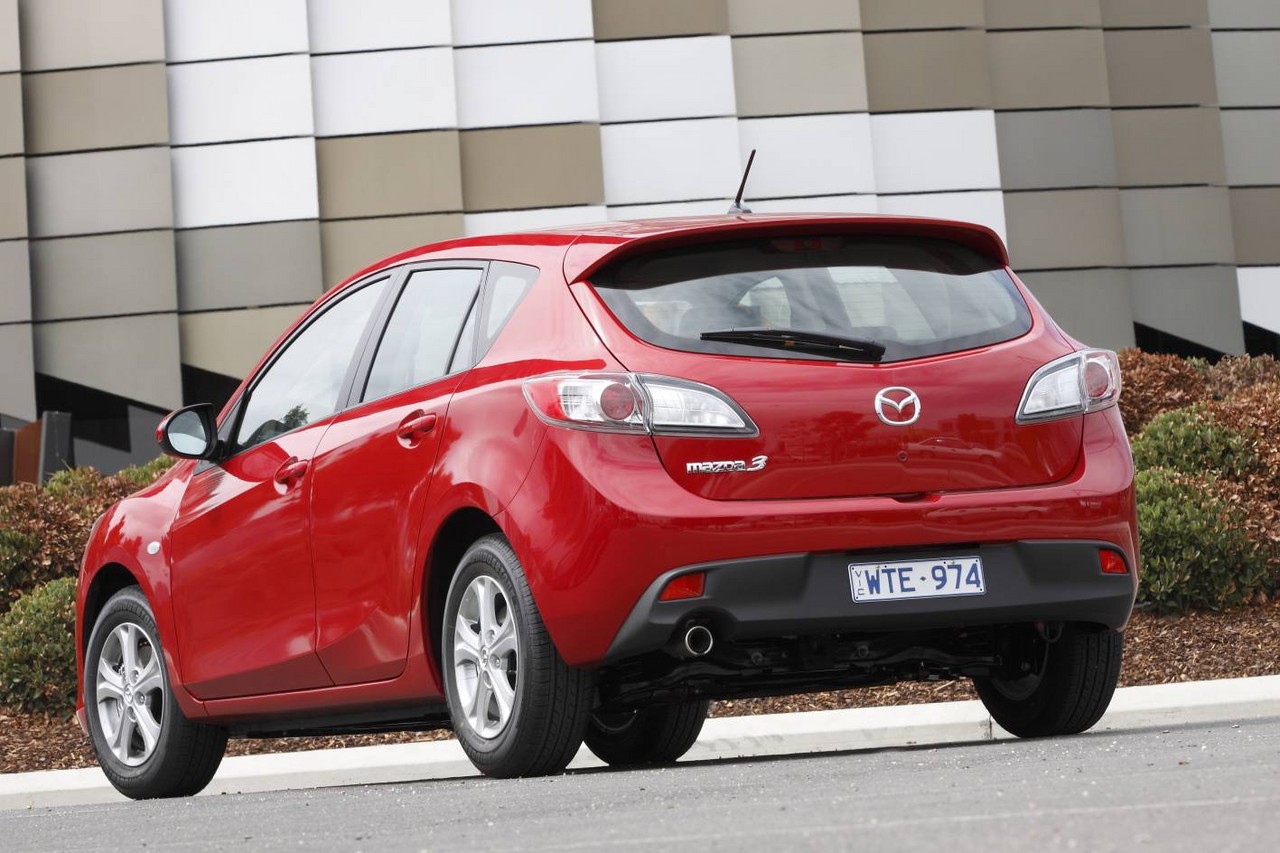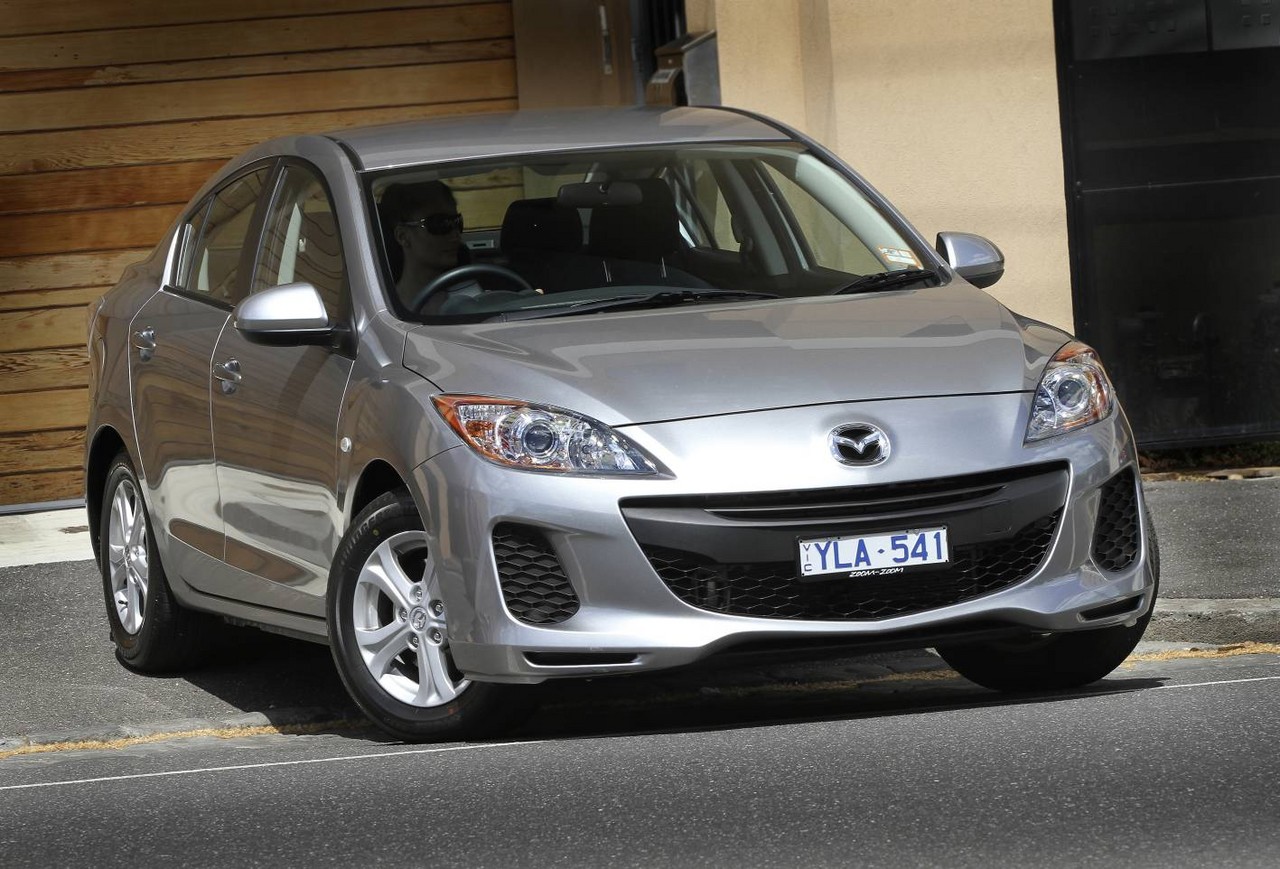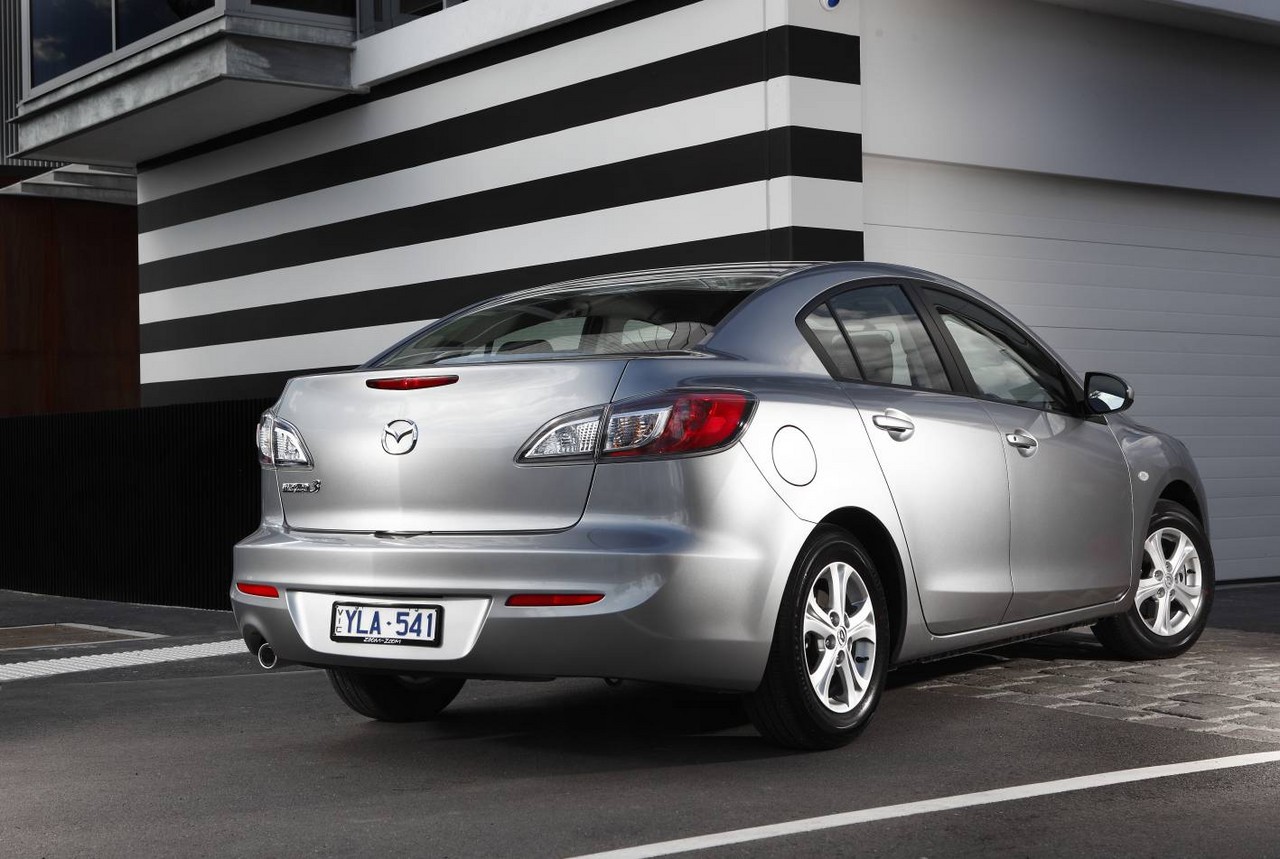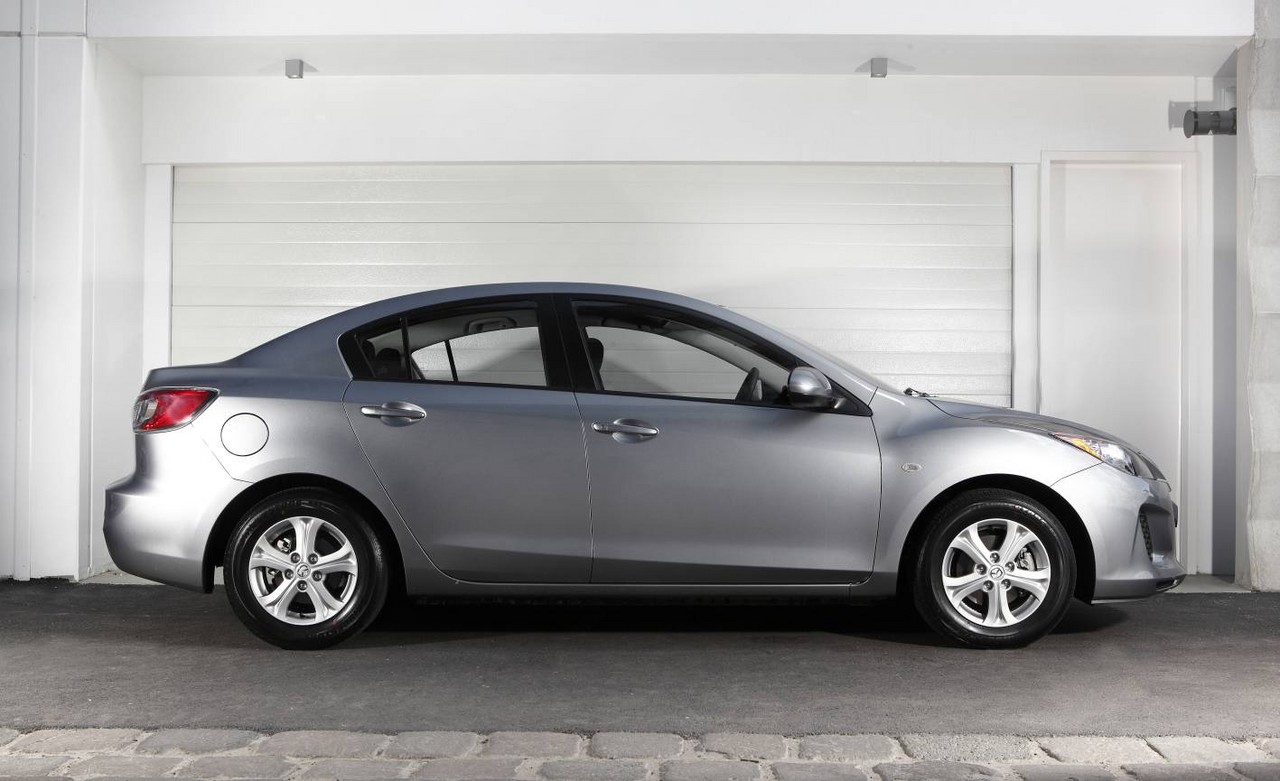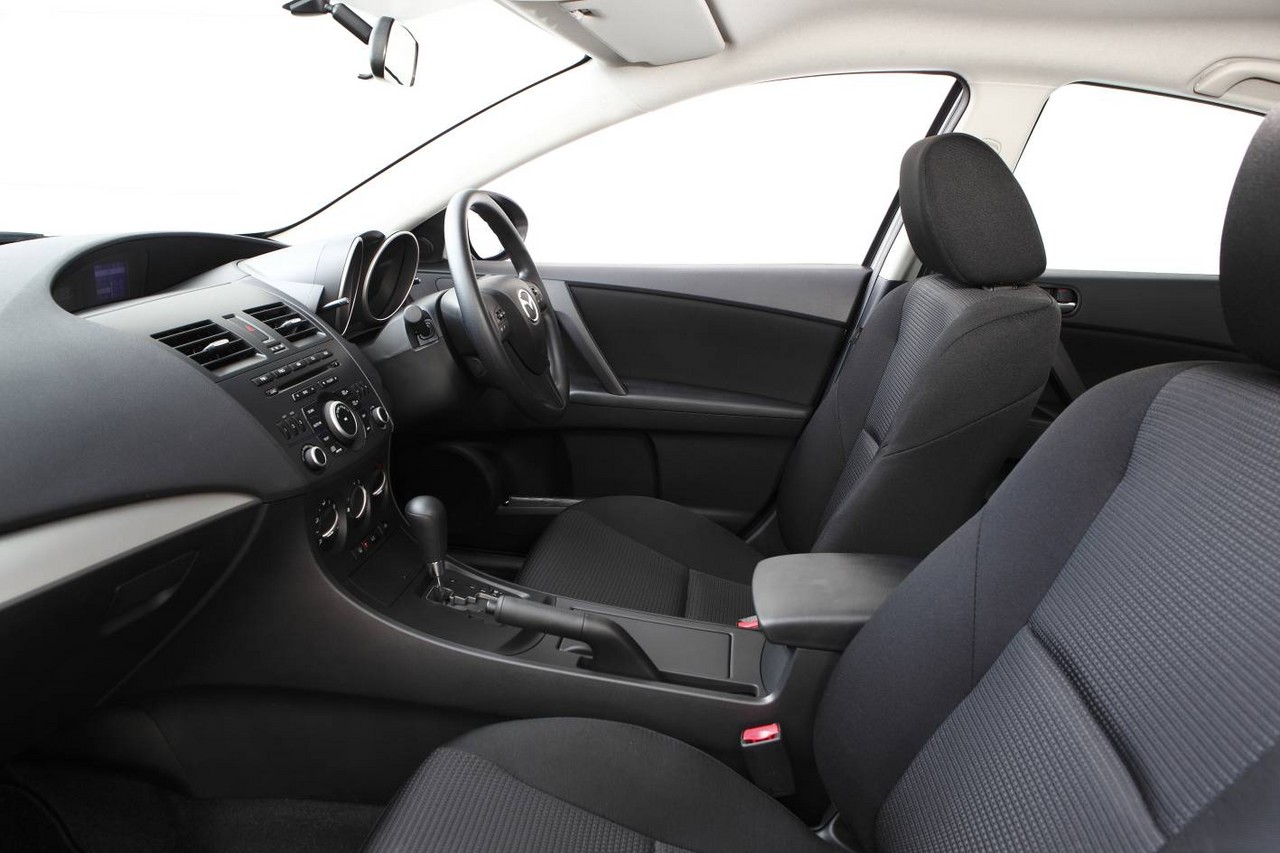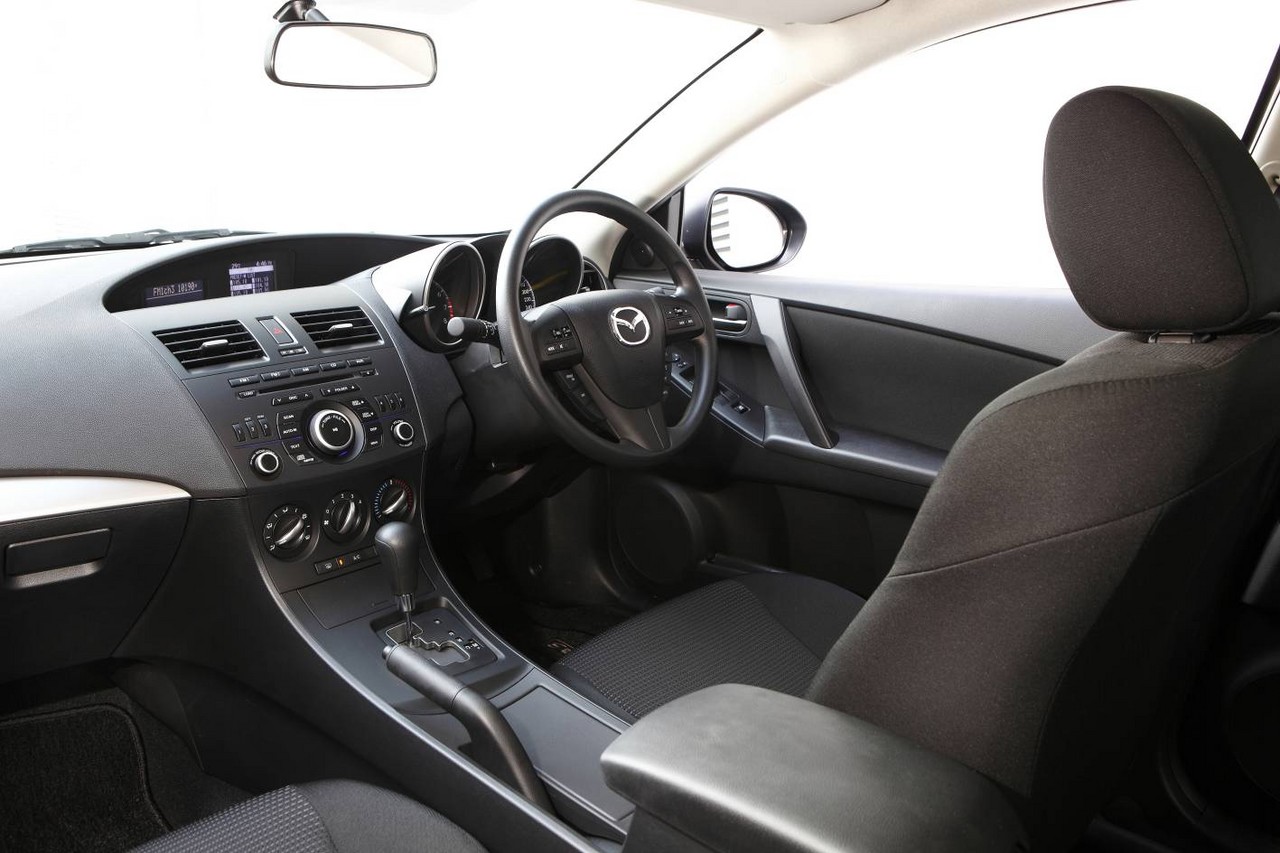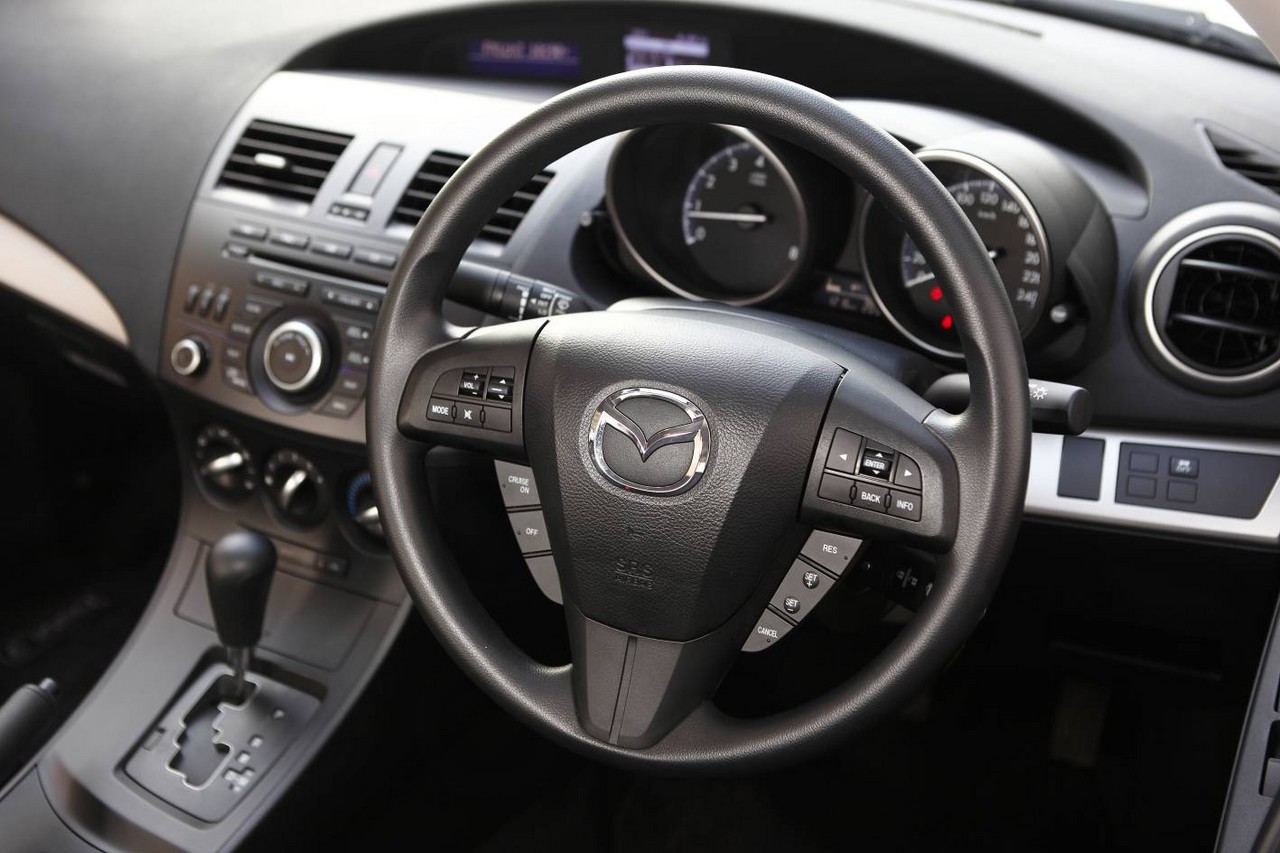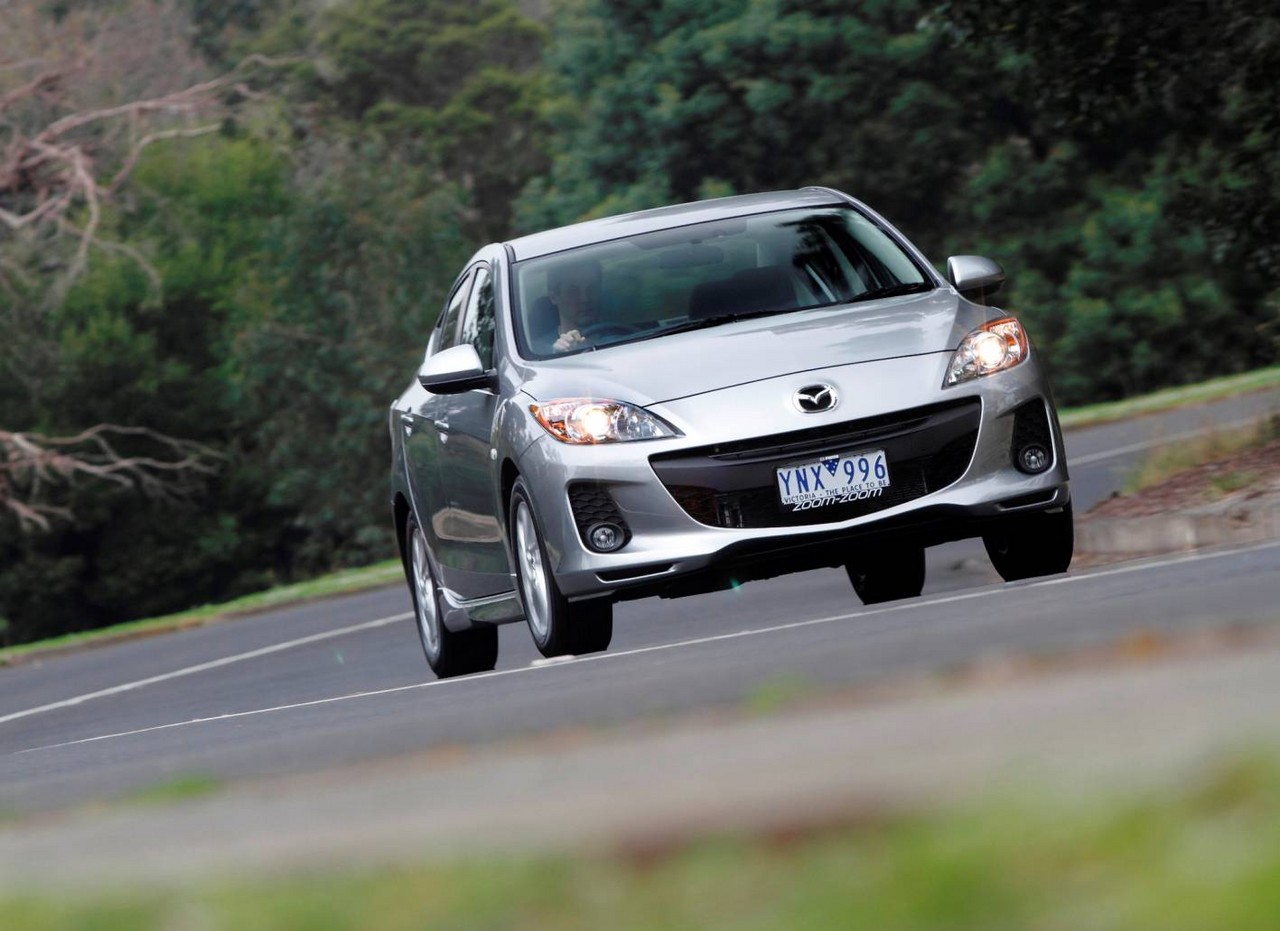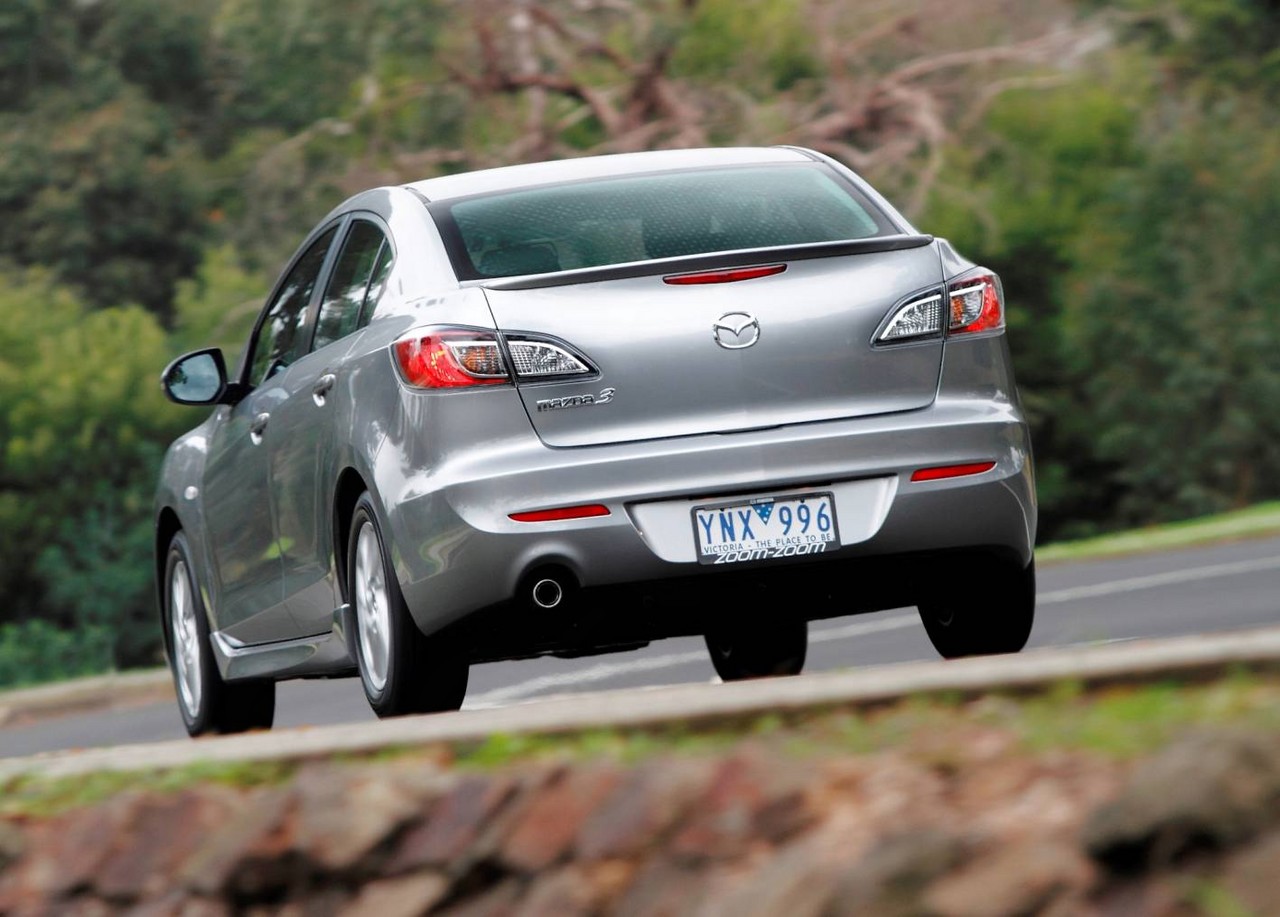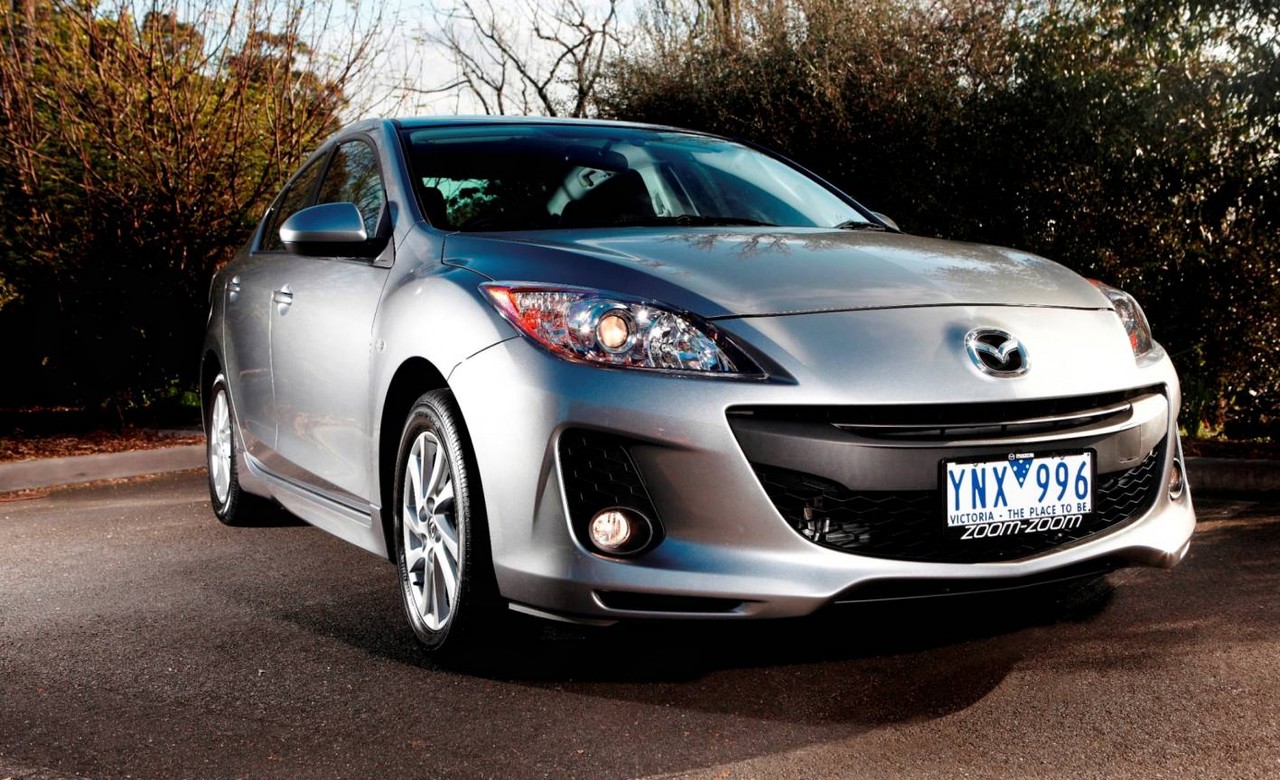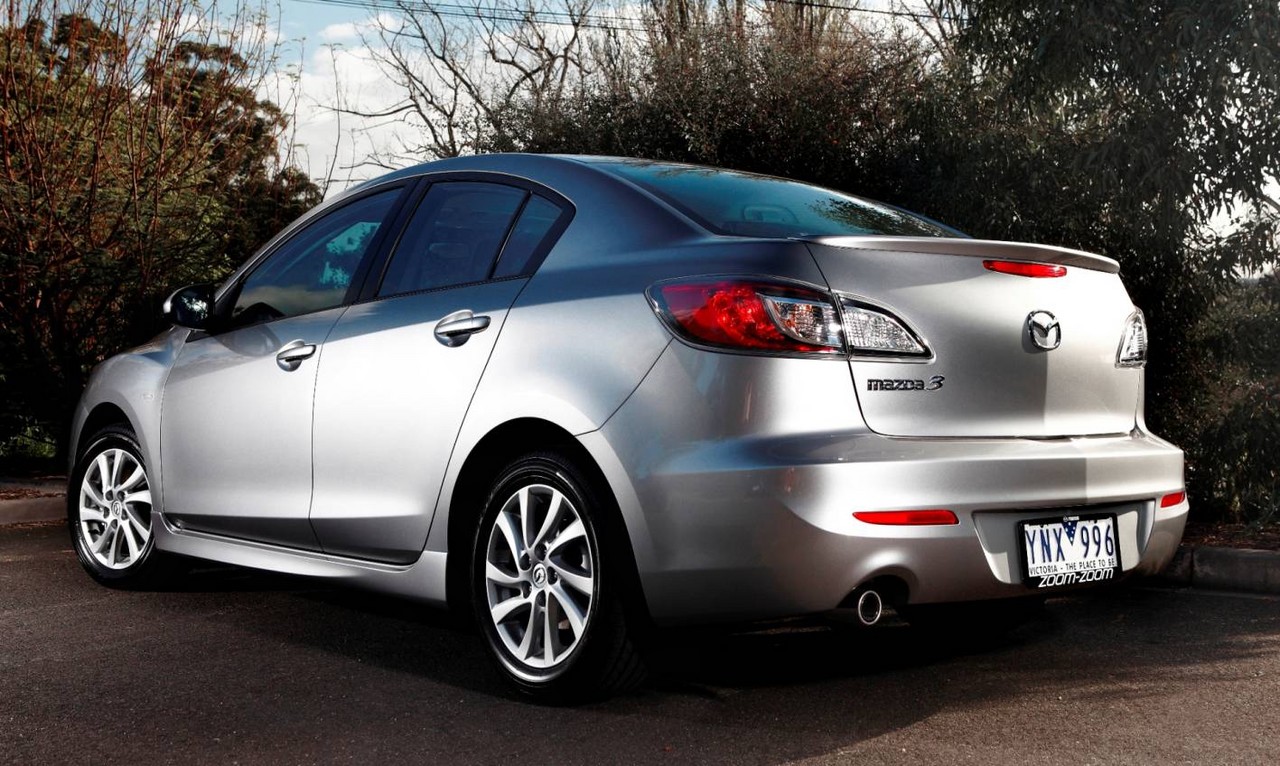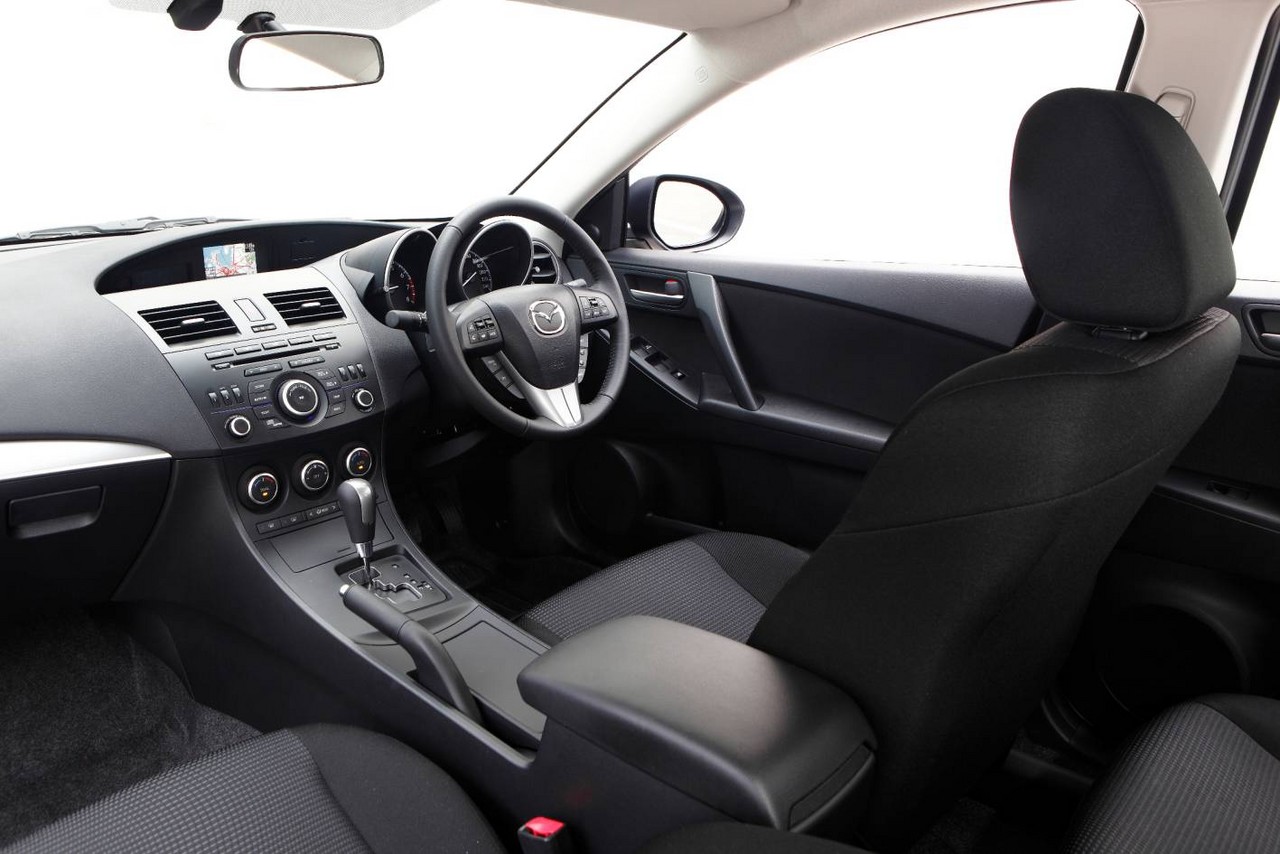
- Willing petrol engines
- Responsive 2.2-litre turbo-diesel engine
- Impressive ride/handling balance
- Generally, well-weighted steering…
- … but lack of steering feel for Maxx Sport
- More refined than Mazda BK Mazda3 predecessor, but interior still noisy
- Driving position lacks adjustment
- Limited rear seat legroom
Review: Mazda BL.I Mazda3 (2009-11)
Overview
Released in April 2009, the Mazda BL Mazda3 was available as a sedan or hatchback. Manufactured in Hofu, Japan, the Mazda3 range initially consisted of Neo, Maxx, Maxx Sport and SP25 variants. In November 2009, however, the range was expanded with the introduction of a Diesel variant.
Please note that the Mazda BL Mazda3 MPS has been reviewed separately.
Engines
- For the Mazda3 Neo, Maxx and Maxx Sport, the 2.0-litre L3-VE petrol engine had an aluminium block and cylinder head, cast-iron cylinder liners, double overhead camshafts (chain-driven), four valves per cylinder, variable intake valves, a variable-length intake manifold, a stainless steel 4:1 exhaust header and a compression ratio of 10.0:1;
- For the Mazda3 SP25, the 2.5-litre L5-VE petrol engine had similar properties as the L3-VE but had an increased bore and stroke for displacement, a forged-steel crankshaft, steel-molybdenum cylinder liners and a compression ratio of 9.7:1; and,
- For the Mazda3 Diesel, the 2.2-litre MZR-CD R2 2008 diesel engine had a cast iron upper and aluminium lower block, an aluminium cylinder head, Denso HP3 common-rail injection (operating at up to 2000 bar), a variable geometry turbocharger, exhaust gas recirculation, double overhead camshafts, four valves per cylinder, variable intake valve timing, a compression ratio of 16.3:1 and a diesel particular filter.
Dimensions
Based on the same C1 architecture as the BK Mazda3 , the BL Mazda3 hatchback was 55 mm longer (at 4460 mm), while the sedan was 95 mm longer (4580 mm); both bodies, however, were 10 mm wider (1755 mm) and 5 mm taller (1470 mm), while the wheelbase was unchanged (2640 mm). For a stiffer structure, the proportion of high-tensile strength steel was increased from 18 per cent to 35 per cent and a thicker steel sheet plate was used for the front subframe.
Suspension
The BL Mazda3 had MacPherson strut front suspension and independent, four-link rear suspension with coil springs (both with coil springs, gas-filled dampers and anti-roll bars).
| Body | Variant | Engine | Trans. | Peak power | Peak torque |
|---|---|---|---|---|---|
| 5dr hatch or 4dr sedan |
Neo, Maxx, Maxx Sport |
2.0-litre L3-VE petrol I4 | 5sp auto, 6sp man. |
108 kW at 6500 rpm | 182 Nm at 4500 rpm |
| SP25 | 2.5-litre L5-VE petrol I4 | 5sp auto, 6sp man. |
122 kW at 6000 rpm | 227 Nm at 4000 rpm | |
| Diesel | 2.2-litre MZR-CD R2 2008 turbo-diesel I4 | 6sp man. | 110 kW at 3500 rpm | 360 Nm at 1800-2600 rpm |
Safety equipment
Standard safety equipment for the Mazda BL.I Mazda3 Neo included dual front airbags, ABS, electronic brake force distribution, brake assist, traction control, electronic stability control, active front seat head restraints and front seatbelts with pretensioners and load limiters.
All other variants – i.e. the Mazda3 Maxx, Maxx Sport, SP25 and Diesel – were further equipped with front side airbags and full-length curtain airbags (i.e. for front and rear occupants). From April 2010, however, front side and curtain airbags were standard for the Neo.
Brakes
The Mazda BL.I Mazda3 was offered with three braking packages:
- The Mazda3 Neo, Maxx and Maxx Sport had 278 mm by 25 mm ventilated front brake discs and 265 mm by 11 mm solid rear discs; and,
- The Mazda3 Diesel and SP25 had 300 mm by 25 mm ventilated front brake discs and 280 mm by 11 mm solid rear discs.
Euro NCAP testing
In Euro NCAP testing , a BL Mazda3 – when fitted with dual front airbags, front side airbags and curtain airbags – received a five star safety rating which included an 86 per cent adult occupant protection rating and an 84 per cent child occupant protection rating. In the frontal offset crash test, protection from serious injury was good for the driver, though there was a slight risk of serious chest injury for the front passenger. In the side impact test, occupant protection was generally good but the side curtain airbag did not deploy fully for the rear seat; this also occurred during the pole test. Under ANCAP’s methodology , this testing resulted in an adult occupant protection rating of 33.33 out of 37.
Features: Mazda3 Neo, Maxx, Maxx Sport, Diesel and SP25
Standard features for the Mazda3 Neo included a six speaker sound system with a CD player, MP3/WMA compatibility and auxiliary inputs, air conditioning, remote central locking, power mirrors and mirrors, a height and reach adjustable steering wheel, height adjustable driver’s seat, 12 volt power outlet, a trip computer and an immobiliser. Beyond this, the Mazda3 Maxx added 15-inch alloy wheels, a six-stack CD player and cruise control.
The Mazda3 Maxx Sport and Diesel variants were similarly equipped and, compared to the Maxx variant, added 16-inch alloy wheels, satellite navigation with a 4.1-inch display, Bluetooth connectivity, a leather-wrapped steering wheel and gearshift and side skirts. Beyond this, the Mazda3 SP25 added dual-zone climate control air conditioning and driver’s seat lumbar adjustment.
April 2010: Mazda3 update
In April 2010, the Mazda3 range underwent a minor update:
- the Neo was fitted with cruise control and steering wheel mounted audio controls;
- the Maxx gained front fog lights and leather-wrapped steering wheel and gearshift; and,
- the Maxx Sport and Diesel were fitted with dual-zone climate control air conditioning.
Related links
- Press Kit: Mazda BL.I Mazda3 (April 2009)
- Specifications: Mazda BL.I Mazda3 (April 2009)
- Press Kit: Mazda BL.I Mazda3 Diesel (November 2009)
Review: Mazda BL.II Mazda3 (2011-13)
Overview
Released in September 2011, the BL Series II (BL.II) Mazda3 introduced a revised range, subtle cosmetic updates and improved fuel economy. The Maxx variant was discontinued and a new SP20 SkyActiv variant was introduced, powered by a new 2.0-litre direct-injection petrol engine (detailed below). Furthermore, revised damper settings provided improved ride quality while the body was more rigid due to underbody bracing, stronger welds and a thicker under-floor steel sheet that also reduced road noise.
Visually, the BL.II Mazda3 could be identified by its front mask with a reshaped five-point grille, air intakes, fog light housings and bumpers – these changes also improved aerodynamic efficiency. Inside, there were new seat fabrics, higher-quality interior surfaces and cool white instrument illumination for standard variants (replacing red).
Mazda3 SP20 SkyActiv engine
Powering the Mazda3 SP20 SkyActiv, the 2.0-litre PE-VPS ‘SkyActiv-G’ petrol engine had an aluminium alloy block and cylinder head, direct fuel injection, double overhead camshafts, four valves per cylinder, variable intake and exhaust camshaft timing (Mazda’s ‘dual S-VT’), a balance shaft, a 4-2-1 exhaust system and a compression ratio of 12.0:1.
The SkyActiv engine also featured an ‘i-stop’ function which enabled it to shut down when the vehicle was stationary in traffic.
| Body | Variant | Years | Engine | Trans. | Peak power | Peak torque |
|---|---|---|---|---|---|---|
| Sedan, Hatch |
Neo, Maxx Sport |
2011-13 | 2.0-litre L3-VE petrol I4 | 5sp auto, 6sp man. |
108 kW at 6500 rpm | 182 Nm at 4500 rpm |
| Diesel | 2011-13 | 2.2-litre MZR-CD R2 2008 turbo-diesel I4 | 6sp man. | 110 kW at 3500 rpm | 360 Nm at 1800 rpm | |
| SP20 SkyActiv | 2011-13 | 2.0-litre PE-VPS petrol I4 | 6sp auto | 113 kW at 6000 rpm | 194 Nm at 4100 rpm | |
| SP25 | 2011-13 | 2.5-litre L5-VE petrol I4 | 5sp auto, 6sp man. |
122 kW at 6000 rpm | 227 Nm at 4000 rpm |
Features
Compared to its BL.I predecessor, standard features for the BL.II Neo were extended to include 15-inch alloy wheels. The Maxx Sport and Diesel variants gained automatic headlights and rain-sensing wipers, though the six-disc CD players were replaced with a single disc unit.
The SP20 SkyActiv was similarly equipped to the Maxx Sport and Diesel, but distinguished by certain cosmetic highlights (blue-ringed headlight lenses, scuff plates, blue instrument backlighting and silver interior highlights). The SP20 SkyActiv was also fitted with bigger brakes as per the SP25 and Diesel variants, including 300 mm front discs.
The SP25, however, gained a ten speaker sound system, leather seats, bi-xenon headlights with washers, automatic headlights, rain-sensing wipers, proximity key and power-operated sunroof. Like the Maxx Sport and Diesel, however, the six-disc CD player replaced with a single disc unit.
September 2012: Mazda3 update
From September 2012, USB connectivity and Bluetooth audio streaming and mobile phone connectivity were standard across the range. The MPS variants underwent a minor cosmetic update with dark metallic alloy wheels, shark-fin antennae and Black Mica paint finishes for the door mirrors, rear lower bumper and part of the rear spoiler.
Brochure
Related links
- Press Kit: Mazda BL.II Mazda3 (September 2011)
- Specifications: Mazda BL.II Mazda3 (September 2011)
- Wikipedia.org: Mazda BL Mazda3
